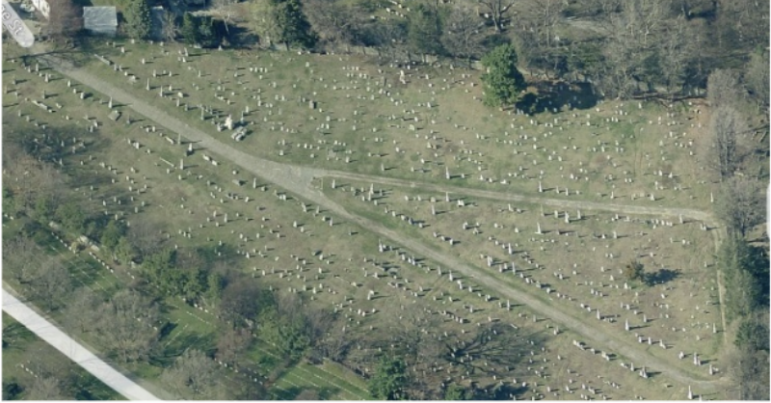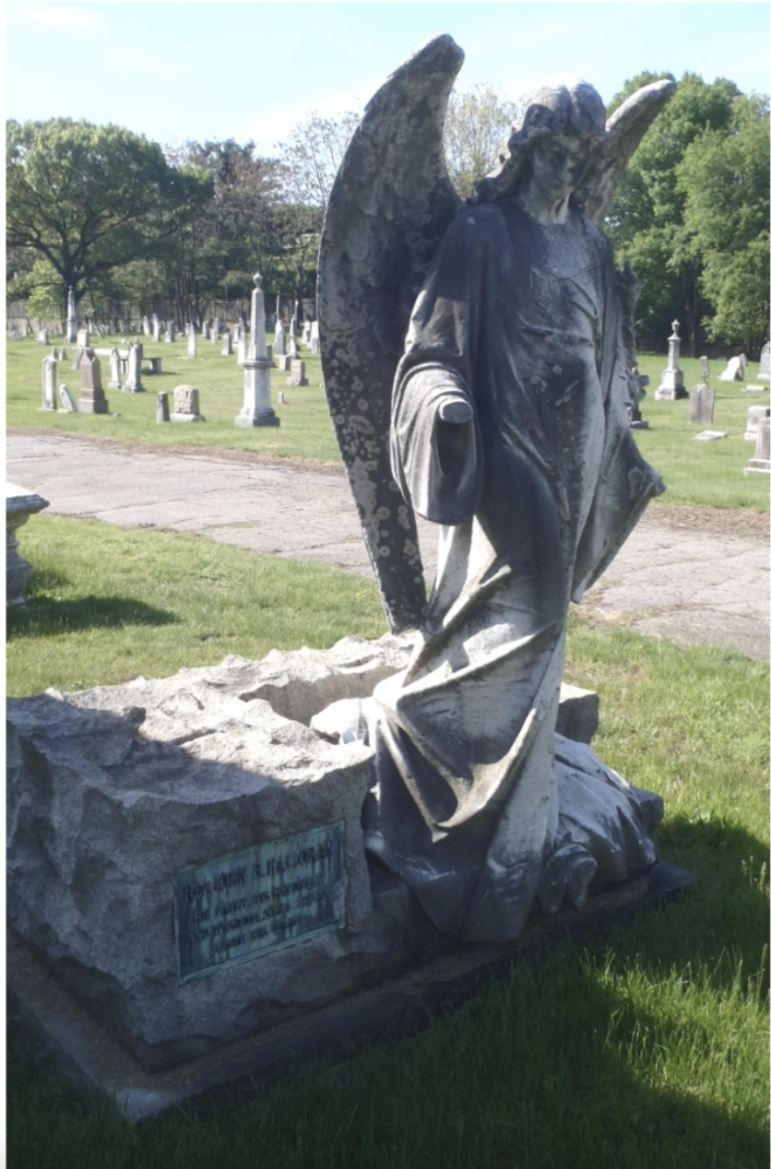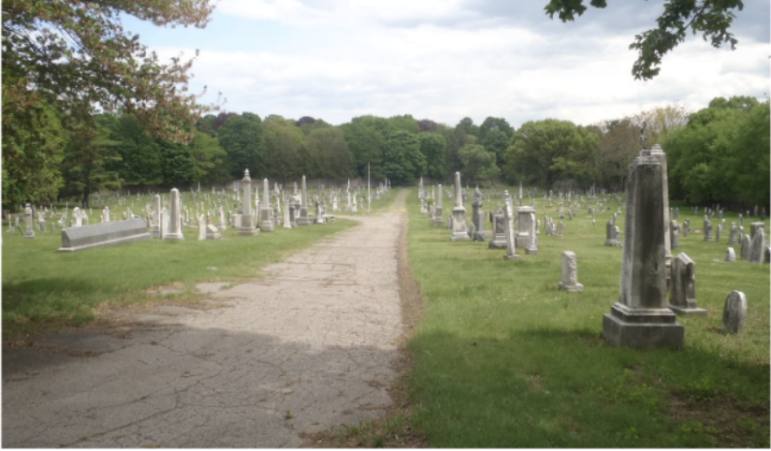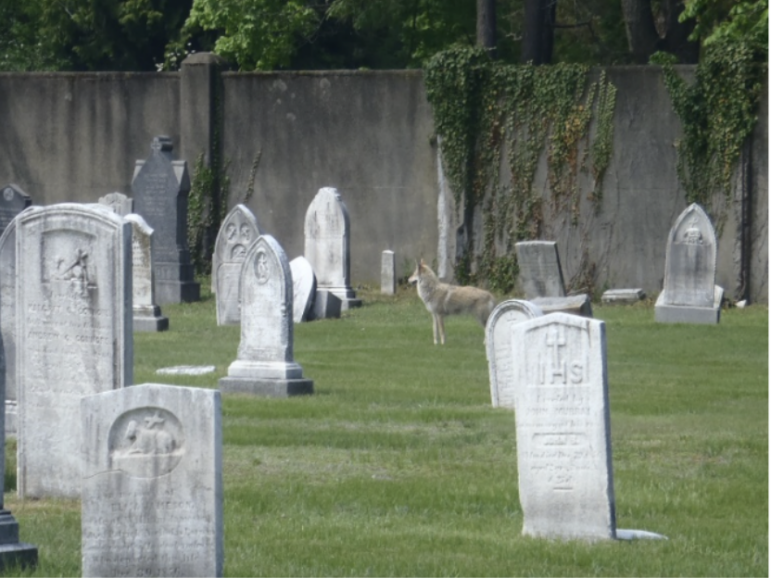
This article is part of a series on local history provided by the Historical Society of Watertown. It was written by Joyce Kelly, Board member of the Historical Society of Watertown. Joyce writes articles for the newsletter and is the newsletter editor. This was published in our January 2016 newsletter, “The Town Crier.”
Almost single-handedly, Bill McEvoy has become a one-man “Friends of Sand Banks Cemetery.” Already a volunteer at Mount Auburn Cemetery researching historical data utilized by their docents for tours and talks, Bill became interested in the adjacent Mount Auburn Catholic Cemetery (also known as Sand Banks Cemetery and Cottage Street Cemetery) while researching local Civil War soldiers for programs at Mount Auburn commemorating the Sesquicentennial of the Civil War (1861-1865). He found at least 140 of them there and soon his concern extended to the rest of this mainly overlooked burial ground.
Sand Banks Cemetery is owned by, and receives minimal care from, the Archdiocese of Boston. Not all graves are marked and many of the monuments are weathered and in need of repair. Many of the monuments have fallen face up/down and others are in danger of falling. There are 23,000+ people buried in a little less than 7 acres.
If you look at an aerial view of Mount Auburn Cemetery from any search engine you will notice the lush tree cover. The Catholic Cemetery is the wedge of barren ground to the left. Sand Banks Cemetery is entirely located in Watertown. Mount Auburn Cemetery, despite its Cambridge address, is 93% in Watertown.
In 2010, the Historical Society put Bill in touch with a former Board member of the Society, Ken Rand, who had done research on the cemetery in the 1990s, and had made copies of the records that were held at the Calvary Catholic Cemetery in Waltham before the records were transferred to the Catholic Cemetery Association at Holy Cross Cemetery at Malden. In late fall of that year, Bill and a few Historical Society members met Ken at the cemetery for a walk through and some background on Ken’s research.
Ken’s copies were from a bound book, noting the name and date of burials listed by month. The copies included pages from January 1, 1885 to 1947 (approx. 6,500 names) with the exception of January 1, 1910 – June 1, 1911. He also had copies of some lot cards from burials after 1947. Ken had prepared a range map of the cemetery that he also made available to Bill and the Historical Society.
Bill made copies of this information and in 2012 began to post it into an Excel spreadsheet and then to www.FindAGrave.com as he went along. That was the initial goal of the project.
Continuing to search for missing records, he researched names in the Archdiocese of Boston’s Archives in Braintree, gaining access to the burial book from the first burial in April 1854 to June 1882 (approx. 16,000 names). By the end of 1864, 99% of the 5,321 lots had been sold. Records are missing from July 1, 1882 to December 31, 1884.

Bill then searched records on Ancestry.com, Familysearch.com and the Massachusetts Secretary of State’s on-line recorded deaths from 1841 to 1910. He became interested in the causes of death, occupations, residences, places of death, places of birth, spouses’ names, maiden names, parents’ names and their places of birth.
A review of the vital statistic death records from 1854 to 1920 revealed this (as well as other information): Most of people buried at Catholic Mount Auburn Cemetery resided in the North End Section of Boston. The second most common place of residence was Cambridge. Most of the lots were purchased by people who were born in Ireland. It is likely that the residents of the Catholic Mount Auburn Cemetery are people who immigrated around the First Irish Famine or their post-immigration descendants. The study also reflects residents from the Catholic Portuguese immigration, two Catholic Africans, 140 Irish Civil War Veterans, 13 Priests and 9 Physicians. There are 25 known victims of homicide.
When the data is viewed sorted, in order by City/town or Street, the causes of death indicate that life was difficult from the immigrants of the First Famine. There are 20 suicides in this consecrated ground, many deaths from teething, cholera, croup, bronchitis, deaths from childbirth in older women, laborers who died at work leaving families without support, and many children who drowned or were scalded. A review of the deaths on certain streets indicates that many members of families died in close order. If a worker died on the job they just put another immigrant laborer in their place. Most men were laborers and many died in workplace accidents. The largest cause of deaths was from communicable lung diseases.

In records, Bill often found burials being noted as at “Mount Auburn” instead of Catholic Mount Auburn. The staff at the Mount Auburn Cemetery indicated that, over the years, people have come to that cemetery looking for the graves of their relatives. Those names noted in the municipal death records as being buried at “Mount Auburn” are not noted in the burial records of Mount Auburn Cemetery.
In 2013, Mr. McEvoy was presented with the Historic Resources Preservation Award from the Watertown Historical Commission for this work. Bill has generously shared the results of this on-going project and continues to find valuable information. The searchable spreadsheet he has created will be posted on our website in February 2016. It will also be shared with the Watertown Free Public Library, the Watertown Dept. of Public Works and the town’s Veterans Agent. An interesting side note – Bill found his maternal great-great-grandparents buried in the cemetery in an unmarked grave, as well as a few distant cousins.

The information that Bill compiled over a period of four years is available to download as an Excel spreadsheet from our website on the Resources webpage. Further information about the project, including Bill’s methodology and the slideshow he presented at the March 23, 2016 Historical Society program is also located there.
Last year Bill self-published a book about the cemetery. It is available in a link on our website to download or to read. www.HistoricalSocietyOfWatertownMA.org
Read Bill McEvoy’s books: The first, in cooperation with the Boston Public Library, they can be read, or downloaded here.
And, two other books are on archive.org
Rainsford Island: A Boston Harbor case study in public neglect and private activism:
There are also a one-hour videos for each on Youtube under the same titles.
Alice North Towne Lincoln: Boston’s selfless advocate for the poor. 36 People buried at the Catholic Mount Auburn Cemetery died at that “Human Dumping Ground”